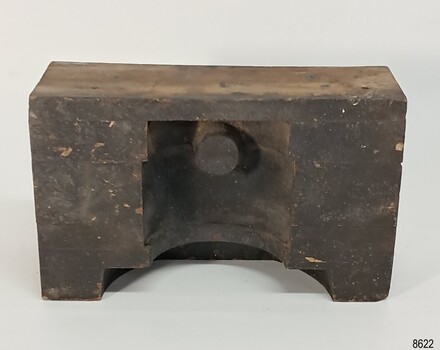Historical information
The wooden pattern is part of a set that are stored in a strong wooden crate. It was used at Briggs’ Brass Foundry for making sand casts. The traditional craft of sand casting is over 2000 years old. The handcrafted process produces brass and copper alloy goods that are well suited to marine use; bells, boat hooks, cowls, propellers, handles, lids, rowlocks, hooks, letters, bolts, rail holders, brackets, deck plates, flanges, rudder guides, portholes and covers. Briggs’ Bronze mixture is a copper-based alloy made from local ingots of copper, tin, zinc and lead in carefully measured quantities. The finished product is non-ferrous and can last indefinitely. The crate of patterns was donated by the Briggs family in the early years of Flagstaff Hill, along with other related items such as brassware, tools and machinery.
The donated items were displayed in a simulated Brass Foundry in the Village along with other working crafts, trades and services found in a Maritime town. The items were on show from the completion of the building in 1986 until 1994 when the building was repurposed. The patterns represent the trades of foundering and metalwork, both supporting maritime industries such as shipwrights and boatbuilders. Farmers, manufacturers and other local industries also needed the castings made by foundries. The Brass Foundry included a historic Cornish chimney set up as a working model, to tell the story of smelted metal heated in furnaces then be poured into the sand moulds. This chimney was made from specially curved bricks and is now about two-thirds of its full height when originally located at the Grassmere Cheese factory.
Significance
The craft of sand-casting from carved wooden patterns to create metal is an example of skills from the past that are still used today.
The foundry pattern set is significant for its association with brass foundries locally and generally in coastal areas of Victoria. Marine industries such as ship and boat building rely on good quality castings for their machinery, equipment and fittings. Briggs Brass was especially formulated using non-ferrous metals to ensure their longevity.
The patterns are associated with the long-running firm Briggs Brass Foundry that specialised in cast goods for the marine industry, ready to supply the needs for once-off or mass-produced items. Their products would have been fitted to sail and steam vessels along coastal Victoria including Warrnambool.
Briggs Marine was also a bell-founder specialist and is also associated with the Schomberg Bell at Flagstaff Hill, having restored it to is former state as a fine example of the bell from a luxury migrant vessel from the mid-19th century.
Physical description
Pattern; rectangular wooden block made from laminated sections of wood painted black. A half-cylinder shape was carved into the long side, and a dowel shape was placed at the lower side. The pattern is part of a set of foundry patterns from Briggs Brass Foundry.
Subjects
- flagstaff hill,
- flagstaff hill maritime museum and village,
- warrnambool,
- maritime museum,
- maritime village,
- great ocean road,
- shipwreck coast,
- briggs' bronze,
- traditional method,
- trade,
- sand cast,
- cast,
- brass alloy,
- copper alloy,
- pattern,
- mould,
- foundry,
- brass foundry,
- metal foundry,
- casting,
- sand mould,
- sand casting,
- marine equipment,
- marine tools,
- marine fittings,
- copper tin zinc lead,
- non-ferrous,
- non-corrosive,
- brassware,
- metalware,
- foundering,
- metalwork,
- maritime,
- bell founders,
- ship chandlers,
- marine products,
- biggs,
- briggs family,
- herbert harrison briggs,
- h h briggs,
- george edward briggs,
- cyril falkiner mckinnon briggs,
- cyril briggs,
- briggs & son brass foundry,
- h h briggs & sons foundry,
- briggs marine,
- alliance casting & engineering solutions,
- grassmere cheese factory,
- cornish chimney,
- curved bricks,
- collingwood,
- moorabbin,
- collingwood foundry,
- moorabbin foundry,
- 1912
References
- Briggs Marine History, About Us
- General Kinematicsf What is Sand Casting?















